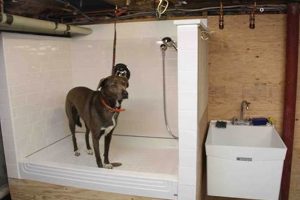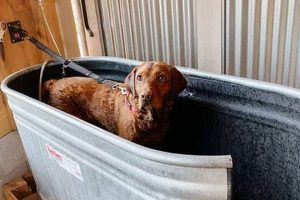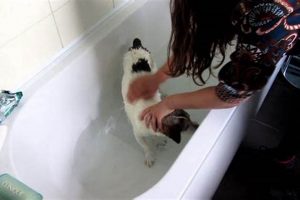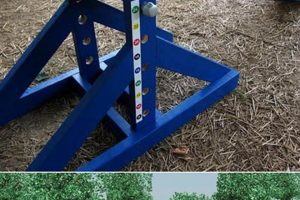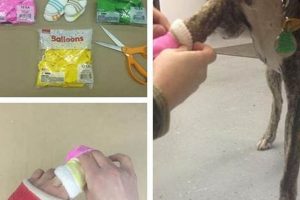A self-constructed canine lounger provides a personalized resting place for a domestic animal. These custom creations, often fashioned from repurposed materials or readily available components, offer an alternative to commercially manufactured pet beds. The final product is a comfortable and supportive structure designed to accommodate the size and preferences of the dog.
The construction of such an item can result in several advantages. It can be a cost-effective solution compared to purchasing pre-made options, especially when utilizing recycled materials. Furthermore, it allows for tailoring the size, shape, and style to perfectly fit the available space and complement the owner’s home decor. Historically, creating custom pet furnishings has been a practice driven by practicality and resourcefulness.
The subsequent sections will delve into various aspects of building a personalized canine resting area, including material selection, construction techniques, and design considerations. It will also address potential safety concerns and offer guidance on creating a durable and comfortable haven for a beloved pet.
Construction Advice for Canine Loungers
Effective construction of a canine lounger requires careful planning and execution to ensure both comfort and durability. The following advice offers essential considerations for a successful project.
Tip 1: Material Selection: Prioritize durable and non-toxic materials. Consider the dog’s chewing habits and opt for fabrics that can withstand wear and tear. Untreated wood or low-VOC paints are preferable for safety.
Tip 2: Structural Integrity: Ensure the frame is robust and can support the dog’s weight without collapsing. Reinforce joints with screws and wood glue for added stability. Corner brackets are advisable for large breeds.
Tip 3: Cushioning and Support: Select a high-density foam or memory foam for the cushion. This provides adequate support for the dog’s joints and prevents flattening over time. The cushion should be properly sized to fit the frame.
Tip 4: Fabric Choice: Opt for machine-washable and stain-resistant fabrics. Canvas, denim, or upholstery-grade materials are suitable choices. Darker colors can help conceal dirt and fur.
Tip 5: Safety Considerations: Eliminate any sharp edges or protruding hardware. Ensure all staples or tacks are securely fastened and hidden from view to prevent injury. Avoid using small parts that could be swallowed.
Tip 6: Accessibility: Consider the dog’s age and mobility when designing the height of the lounger. A lower profile is beneficial for senior dogs or those with joint problems. Add a ramp if necessary.
Tip 7: Waterproofing: Implementing a waterproof liner beneath the fabric can protect the cushion from accidents or spills. This extends the lifespan of the cushion and simplifies cleaning.
Following these recommendations will contribute to the creation of a safe, comfortable, and long-lasting resting place for the canine companion. A well-constructed lounger enhances the dog’s comfort and provides a designated space within the home.
The concluding section will provide insights on customizing and maintaining the structure for optimal longevity and aesthetic appeal.
1. Durability of Materials
The selection of resilient components is a crucial determinant in the long-term viability of a self-constructed canine lounger. Material durability directly impacts the structure’s ability to withstand daily use, environmental factors, and the dog’s inherent behaviors, such as chewing or scratching.
- Frame Construction Materials
The frame’s robustness dictates the overall stability and lifespan of the structure. Hardwoods, such as oak or maple, provide superior strength and resistance to deformation compared to softwoods like pine. Metal framing offers a high degree of durability but may require specialized tools and skills for assembly. The chosen material must be able to support the dog’s weight without compromising the structural integrity of the lounger.
- Fabric Resistance to Abrasion
The upholstery fabric is subjected to constant friction from the dog’s movement and scratching. Durable fabrics, like canvas, denim, or microfiber, offer enhanced resistance to abrasion and tearing compared to less robust options. The fabric’s weave and fiber content directly impact its ability to withstand wear and tear. Pre-treating fabrics with stain-resistant coatings can further extend their lifespan and maintain their aesthetic appeal.
- Cushioning Material Degradation
The cushioning material’s ability to retain its shape and support over time is essential for the dog’s comfort and the lounger’s longevity. High-density foam or memory foam provide superior support and resistance to compression compared to less dense alternatives. The cushioning material should also be resistant to moisture and microbial growth to prevent odors and degradation. A waterproof liner can protect the cushioning from accidental spills and extend its lifespan.
- Fastener and Hardware Corrosion
The fasteners and hardware used in the construction of the lounger are susceptible to corrosion from moisture and environmental exposure. Stainless steel or coated hardware offers superior resistance to rust and degradation compared to standard steel fasteners. The use of appropriate adhesives and sealants can further protect the hardware from corrosion and ensure the structural integrity of the lounger over time.
The interplay of these material properties determines the overall durability and value of the self-constructed canine lounger. While initially cheaper materials may reduce upfront costs, investing in durable components ensures a longer lifespan, reduced maintenance, and enhanced overall value. Prioritizing material quality translates into a more sustainable and cost-effective solution over the long term, providing the dog with a comfortable and safe resting place for years to come.
2. Comfortable Cushioning
Within the realm of self-constructed canine loungers, the provision of adequate and comfortable cushioning represents a pivotal element influencing the dog’s utilization and satisfaction. Cushioning directly impacts the orthopedic support, thermal regulation, and overall sensory experience for the animal, thereby determining the success of the undertaking.
- Density and Support
The density of the cushioning material dictates its load-bearing capacity and ability to conform to the dog’s body. High-density foam provides firm support, distributing weight evenly and minimizing pressure points. This is particularly crucial for larger breeds or dogs with joint ailments, where inadequate support can exacerbate discomfort and mobility issues. Conversely, excessively soft cushioning may lack sufficient support, leading to postural problems and reduced comfort. Examples of appropriate materials include memory foam or high-density polyurethane foam, selected according to the dog’s size and specific needs.
- Thermal Regulation
The cushioning material’s thermal properties influence the dog’s comfort level across varying ambient temperatures. Materials like cotton or open-cell foam allow for increased airflow, promoting breathability and preventing overheating. Conversely, closed-cell foam or synthetic materials may trap heat, leading to discomfort in warmer climates. The choice of material should reflect the prevailing climate and the dog’s individual thermal preferences. A removable, washable cover made of breathable fabric can further enhance thermal regulation and hygiene.
- Allergenicity and Hygiene
The cushioning material’s inherent allergenic properties and susceptibility to harboring allergens are critical considerations for dogs with sensitivities or allergies. Hypoallergenic materials, such as latex foam or synthetic fills, minimize the risk of allergic reactions. Regular cleaning and maintenance are essential to prevent the accumulation of dust mites, pet dander, and other allergens. A waterproof liner beneath the outer cover can protect the cushioning from moisture and prevent mold growth, contributing to a cleaner and healthier resting environment.
- Durability and Longevity
The cushioning material’s resistance to compression, tearing, and degradation directly impacts its lifespan and the long-term comfort provided. Durable materials, such as high-density foam or fiberfill, retain their shape and support over extended periods. Reinforcing the seams and using high-quality stitching can prevent tearing and extend the life of the cushion. Regular rotation and fluffing of the cushion can help maintain its shape and prevent uneven wear. Selecting materials known for their resilience ensures sustained comfort and value over the lifespan of the lounger.
These facets demonstrate the multifaceted role of comfortable cushioning in the successful creation of a do-it-yourself dog sofa. By carefully considering the density, thermal properties, allergenicity, and durability of the cushioning material, the constructor can optimize the comfort, health, and longevity of the final product, providing the canine companion with a personalized and supportive resting place.
3. Structural Stability
The structural stability of a self-assembled canine sofa directly dictates its functional lifespan and the safety of the animal utilizing it. A lack of stability introduces a high probability of collapse or deformation under the dog’s weight and movement, leading to potential injuries. The selection of materials and construction techniques are causally linked to the overall stability; for instance, using thin, untreated wood for the frame will invariably result in a less stable structure compared to one built with reinforced hardwood. Real-world examples include sofas that fail at stress points, such as corners or leg attachments, due to inadequate joint reinforcement. Understanding this connection is practically significant for preventing accidents and ensuring the canine has a safe and reliable resting place.
Practical application of stability principles involves several key steps. The selection of appropriate load-bearing materials, such as solid wood or reinforced metal, is paramount. Proper joint construction, using techniques like mortise and tenon, or metal brackets, ensures that the sofa can withstand the forces exerted upon it. Distributing weight evenly through a well-designed frame minimizes stress concentration in specific areas. Testing the finished product under realistic load conditions before allowing the dog to use it is crucial for identifying and addressing any weaknesses. Furthermore, considerations for the size and weight of the dog for whom the sofa is being constructed are necessary. A Great Dane will require significantly more stability than a Chihuahua.
In summary, the structural integrity is not simply a desirable attribute, but a fundamental requirement for any self-constructed canine sofa. Neglecting this aspect results in a potentially hazardous and ultimately unsustainable product. While aesthetic considerations and comfort features are important, they should not be prioritized over the core structural integrity. Addressing the challenges of ensuring stability involves careful material selection, meticulous construction techniques, and rigorous testing. A stable sofa provides not only a comfortable resting place but also peace of mind for the owner, knowing their canine companion is safe and secure.
4. Customizable Design
The inherent versatility of a self-constructed canine sofa stems directly from its customizable design. Unlike mass-produced commercial options, the ability to tailor dimensions, aesthetics, and functionalities to the precise needs and preferences of both the dog and owner defines the core value proposition. This adaptability addresses specific spatial constraints, caters to the unique physical characteristics of the animal, and integrates seamlessly with the existing interior dcor. A direct correlation exists between the degree of customization and the ultimate suitability of the resulting sofa. Instances of commercially produced sofas failing to adequately accommodate larger breeds or clashing with established design schemes underscore the importance of this customizable aspect.
Practical application of customizable design principles manifests in diverse ways. For example, elderly dogs with mobility limitations may benefit from a lower overall height and the incorporation of an integrated ramp. Similarly, canines prone to shedding may necessitate the selection of stain-resistant and easily cleanable upholstery materials. Aesthetic customization allows for the integration of colors, patterns, and textures that complement the owner’s existing furniture, creating a unified and harmonious living space. The ability to incorporate storage compartments for toys or grooming supplies further enhances the functionality of the design. Consideration to specific dog breeds, some being more prone to scratching than others, and material selections to improve the longevity of the “diy dog sofa”.
In summation, customizable design is not merely an optional feature but a foundational element driving the efficacy and appeal of a self-constructed canine sofa. By embracing the principles of adaptability and personalization, the constructor can create a product that surpasses the limitations of commercially available alternatives, providing a comfortable, functional, and aesthetically pleasing resting place for the canine companion. Challenges associated with customizable design involve careful planning, material selection, and the acquisition of necessary skills, but the resulting benefits justify the investment of time and effort. This design element is key to a functional “diy dog sofa”.
5. Size Appropriateness
The dimensional compatibility between a canine and its resting place is a critical determinant of the structure’s utility and the animal’s comfort. Size appropriateness, in the context of a self-constructed canine sofa, directly impacts the dog’s ability to fully utilize the structure, influencing posture, joint health, and perceived security. An undersized sofa constricts movement and prevents the dog from fully stretching or assuming comfortable sleeping positions, potentially leading to musculoskeletal discomfort over time. Conversely, an excessively large sofa may fail to provide a sense of enclosure or security, particularly for smaller breeds, potentially resulting in anxiety or reluctance to use the structure.
Accurate dimensional assessment of the canine is paramount prior to commencing construction. This assessment should encompass both length and width measurements in various resting positions, allowing for adequate space to accommodate the dog’s full extension without constraint. The height of the sofa should be carefully considered, particularly for senior animals or breeds predisposed to joint problems; an excessively high structure necessitates increased effort for ingress and egress, potentially exacerbating existing conditions. Practical application of this principle involves creating a cardboard mock-up of the intended sofa dimensions, allowing the dog to physically interact with the prototype and providing valuable feedback regarding size suitability. This proactive approach mitigates the risk of constructing a sofa that fails to meet the dog’s dimensional requirements.
In conclusion, size appropriateness transcends mere aesthetic considerations, serving as a foundational element in the functional design of a self-constructed canine sofa. Neglecting this aspect can have tangible and detrimental effects on the dog’s comfort, health, and overall well-being. Addressing this challenge requires meticulous planning, accurate measurement, and a thorough understanding of the dog’s individual needs and preferences. A well-proportioned sofa provides not only a comfortable resting place but also promotes long-term musculoskeletal health and a sense of security for the canine companion. It is an essential variable in creating an effective “diy dog sofa”.
Frequently Asked Questions Regarding Canine Sofa Construction
The subsequent questions and answers address common concerns and misconceptions surrounding the self-construction of canine sofas, offering clarification and practical guidance.
Question 1: Is specialized expertise required for constructing a canine sofa?
Extensive woodworking or upholstery experience is not universally necessary. Many designs are achievable with basic tools and fundamental skills. However, more intricate designs necessitate a higher level of proficiency. Resourceful use of online tutorials and pattern guides can offset a lack of prior experience.
Question 2: What are the primary safety considerations during construction?
The elimination of sharp edges, secure fastening of all hardware, and avoidance of toxic materials are paramount. Small parts pose a choking hazard and should be strictly avoided. The structural integrity of the frame must be sufficient to support the dog’s weight without collapse.
Question 3: How does one determine the appropriate size for a canine sofa?
Accurate measurement of the dog in its typical resting positions is essential. The sofa should allow for full extension without constraint. Considering the dog’s age and mobility when determining the height of the structure is advisable.
Question 4: What materials are recommended for enhanced durability?
Hardwoods, such as oak or maple, provide superior frame strength. Durable fabrics, including canvas or denim, resist wear and tear. High-density foam or memory foam cushions maintain their shape and offer optimal support.
Question 5: How can the sofa be made more accessible for senior or mobility-impaired dogs?
A lower profile design minimizes strain during entry and exit. The incorporation of a ramp provides assisted access. Non-slip surfaces prevent accidental slips and falls.
Question 6: What are the best practices for cleaning and maintaining a canine sofa?
Removable and machine-washable covers simplify cleaning. Regular vacuuming removes loose fur and debris. Spot cleaning addresses stains promptly. Waterproof liners protect the cushion from accidental spills.
In summation, the construction of a canine sofa demands careful planning, attention to safety, and a commitment to quality. Addressing these frequently asked questions can assist in achieving a successful and satisfying outcome.
The subsequent section will address design templates.
Conclusion
The preceding discussion has outlined the multifaceted considerations inherent in the design and construction of a self-made canine sofa. Emphasis has been placed on structural integrity, material durability, size appropriateness, customization options, and safety protocols. Effective implementation of these principles dictates the utility, longevity, and overall value of the resulting structure. A comprehensive understanding of these elements ensures a safe and comfortable resting environment for the canine companion.
The successful creation of a “diy dog sofa” represents more than a mere cost-saving endeavor; it signifies a commitment to providing a tailored and thoughtfully constructed space that meets the specific needs of a valued animal. Further research and continued refinement of design and construction techniques will undoubtedly enhance the accessibility and sophistication of this craft, fostering improved well-being for canines and increased satisfaction for their owners. Responsible application of this knowledge is encouraged for optimal outcomes.


